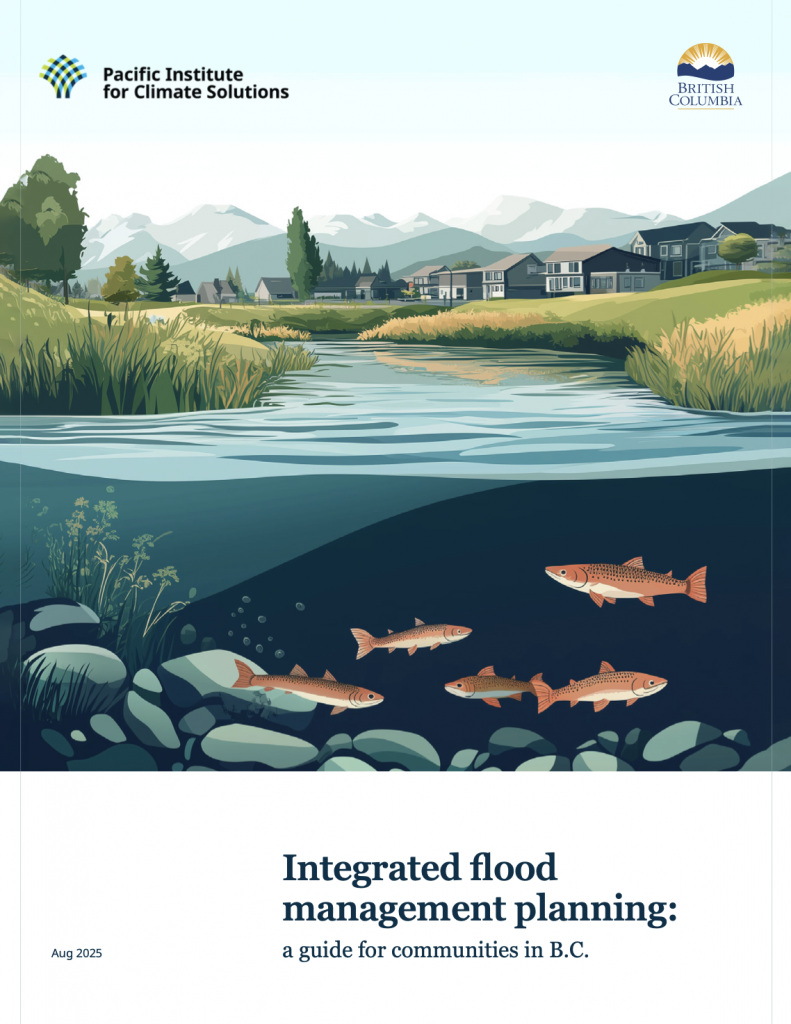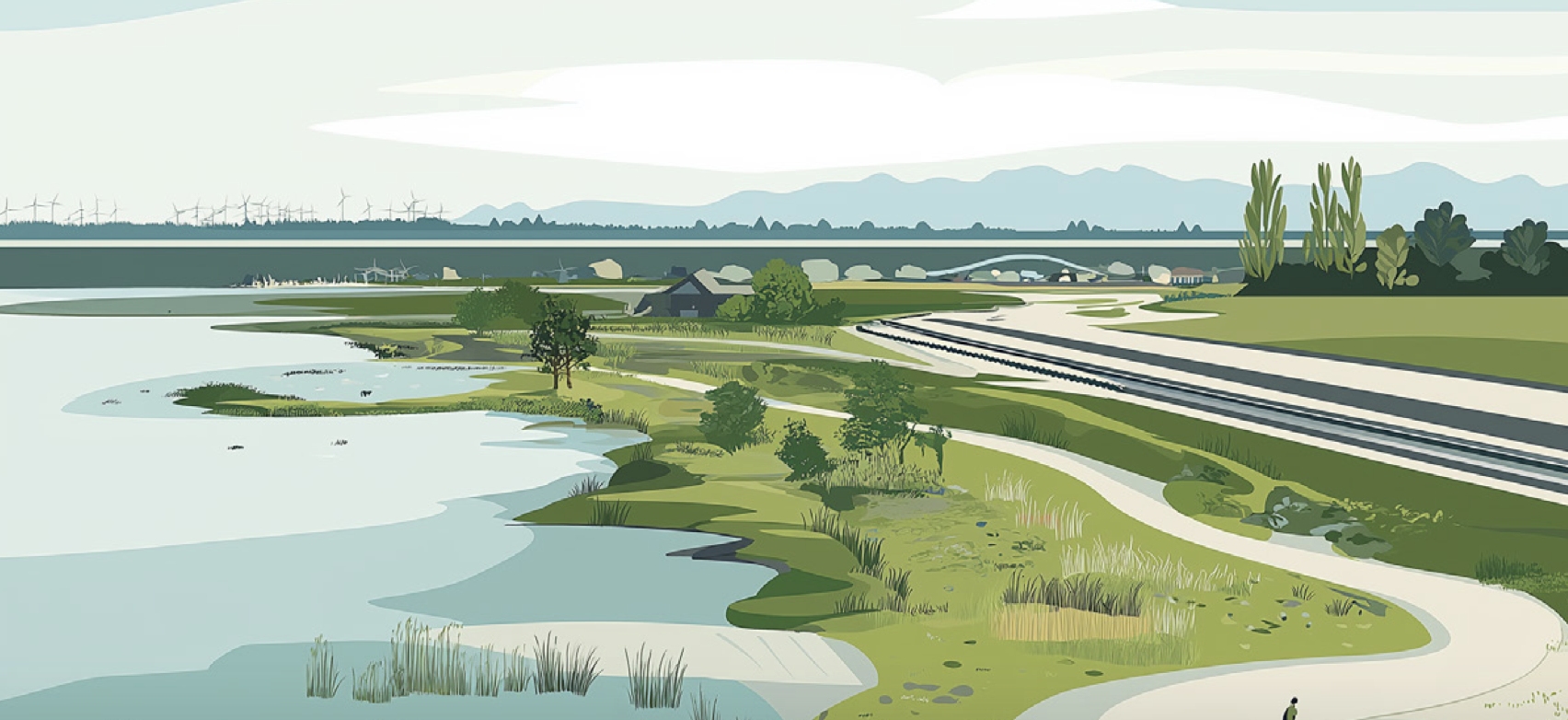by Dr. Kees Lokman
As communities across B.C. face increasing flood risks, they need more integrated and collaborative approaches to planning for floods. Current practices, however, are often limited by jurisdictional boundaries and fragmented decision-making processes.
The 2024 B.C. Flood Strategy calls for the promotion of a better way: integrated flood management plans (IFMPs). These are place-based strategies that prioritize collaboration, equity, and risk reduction.
But how does a community create such a plan? The Living with Water research team has put together a new resource to help. Integrated Flood Management Planning: a guide for communities in B.C., outlines how First Nations, local governments, and other communities can work together to design flexible, inclusive, and climate-ready approaches to flood planning.

A collaborative guide, a collaborative effort
The Living With Water team developed this guide, with contributions or input from:
- the Sharing the Pen team, which included Indigenous leaders who bring deep knowledge of place, governance, and stewardship.
- Staff with the Province of British Columbia
- Research partners and support at West Coast Environmental Law, the University of Victoria, and the University of Waterloo
- Funding and support were provided by the Ministry of Water, Land and Resource Stewardship and the Pacific Institute for Climate Solutions
The team gleaned insights from case studies and flood planning across B.C.to shape this guidance, including work from Surrey, Squamish, Vancouver, Cowichan, and Campbell River.
At its core, integrated flood management is about relationships—between water and land, upstream and downstream, and across communities and governments. Integrated flood management plans provide a structure for aligning efforts, building mutual understanding, and acting early to reduce risk and protect what matters most.
How to build an integrated flood management plan
IFMPs combine both structural measures (like dikes and culverts) and non-structural approaches (like land use planning, education, and nature-based solutions).Our guide outlines a five-step process for developing an IFMP:
- Set the scope and building relationships: Define the geographic area (e.g., watershed, coastal reach), establish respectful governance arrangements, and build trust—particularly between First Nations and local governments.
- Understand Risks: Map flood hazards and assess vulnerabilities (social, ecological, and infrastructure) using geospatial data, climate projections, Indigenous Knowledges, and community insights.
- Select and Evaluate risk reduction and resilience options: Communities need to develop approaches rooted in place-based knowledge and grounded in local flood risks, cultural priorities, and ecological realities. Structured decision-making and evaluation frameworks support transparent, inclusive, and adaptive planning that balances technical feasibility with long-term community values.
- Assemble the IFMP: Consolidate findings and preferred strategies into a document that includes timelines, roles, funding needs, regulatory steps, and monitoring protocols.
- Implement and Adapt the IFMP: Take action, track progress, and adjust over time as conditions change, relationships deepen, and new opportunities arise.
Why use this guide to build an integrated flood management plan?
The report is a helpful tool for communities to save time and work.
Some of the benefits include:
- It provides a shared framework for collaboration: The report offers a common reference point for Indigenous and local governments, practitioners, and provincial agencies to align flood planning across jurisdictions and knowledge systems.
- It supports implementation of the B.C. Flood Strategy: Identified as a deliverable under the Province’s 2024 Flood Strategy, the guide helps implement the call for integrated, values-based, and climate-informed approaches to flood resilience.
- It informs future provincial policy: The report lays the groundwork for embedding integrated flood management principles in provincial land use planning, emergency management, and infrastructure funding programs.
- It advances reconciliation and co-governance: By emphasizing early relationship-building, shared decision-making, and the integration of Indigenous Knowledges, the report supports the broader goal of advancing reconciliation through land and water governance.
- It encourages proactive and holistic planning: The report outlines processes and tools that can help communities move beyond reactive responses to flooding—toward strategies that build long-term resilience while delivering ecological, social, and cultural benefits.
This guide equips communities with the tools and frameworks to develop IFMPs that are proactive, inclusive, and grounded in place. By fostering long-term relationships and integrating diverse knowledge systems, B.C. can move toward a more resilient and just future—one where flood management protects not only infrastructure, but ecosystems, cultures, and livelihoods.
Dr. Kees Lokman is a project principal investigator with the Living with Water project, associate professor and chair of Landscape Architecture at the University of British Columbia, and director of the UBC Coastal Adaptation Lab.
